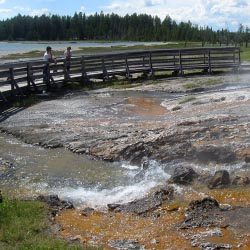


Hype:
Firehole Lake Drive is a one-way road south of Madison Junction in Yellowstone National Park. The road passes several pools, geysers, and two boardwalks.
Trail Condition: Class 0 (Trail is paved. No elevation gain.)
Time: 15 minutes for the boardwalks
Length: 0.4 miles for the boardwalks
Elevation Gain: Negligible
Fees: Entrance fee
Recommended Ages:
 | 0-3 |
 | 4-11 |
 | 12-19 |
 | 20-49 |
 | 50-69 |
 | 70+ |
Recommended Months to Visit:
| Jan |
| Feb |
| Mar |
| Apr |
| May |
| Jun |
| Jul |
| Aug |
| Sep |
| Oct |
| Nov |
| Dec |
Navigate to 44.535210, -110.817390.
The following information was taken from the Fountain Paint Pot Area Trail Guide![]() , which is available at the Fountain Paint Pot trailhead.
, which is available at the Fountain Paint Pot trailhead.
From Fountain Paint Pot, drive 1.2 mile (2 km) south (toward Old Faithful) to Firehole Lake Drive, a 2-mile (3 km) drive that passes geysers, hot lakes, hot springs even a hot cascade.
To see Firehole Spring, stop at the first long pullout on your left. Early explorers thought the large bubbles looked like flashes of light hence the origin of the spring's name.
At the next parking area, view Surprise Pool. Early visitors threw sand in the pool to cause "surprise" boiling. Luckily their behavior caused no permanent damage, and you can still enjoy the deep blue color and wide intricate overhangs of sinter.
Whether Great Fountain Geyser is in eruption or not, you will see why the early explorers were so enthusiastic about this geyser's beauty. Eruptions average 100 feet (31 m) high, but some visitors are rewarded with rare "superbursts" of 200 feet (61 m) or more. Eruptions last 45-60 minutes in a series of bursts. Great Fountain takes 10-14 hours to rebuild to an eruption. The pool slowly fills, then begins to overflow 70-100 minutes before the eruption.
Like most geysers, Great Fountain experiences periods of irregularity. But, for the most part, it is dependable. While waiting for its display, watch for eruptions of White Dome Geyser to the northwest along the one-way road.
The massive cone of White Dome Geyser indicates it has probably been erupting for hundreds of years. From such an enormous cone one might expect enormous eruptions. However, its narrow vent has been nearly sealed off with sinter deposits. Eruptions reach a height of approximately 30 feet (9 m)- the height of the entire cone. The eruption lasts about two minutes before gradually changing into spray and steam. Intervals between eruptions are usually 30-35 minutes, but may be as long as 3 hours.
In the 1930s, a road was built right across the mound of Pink Cone Geyser. Fortunately this seems to have had little effect on the geyser's performance.
No record of Pink Cone erupting exists until 1887. From 1889 to 1936, it seemed to be dormant; then for the next 23 years, it erupted approximately every two days. After the Hebgen Lake Earthquake in 1959, its intervals were as short as 50 minutes with eruptions of similar duration. Through the years, the time between eruptions has increased to approximately 20 hours; the duration is about 100 minutes; and it erupts up to 30 feet (9 m).
Small amounts of manganese oxide cause Pink Cone's color. This mineral also comprises many of the brown, gray, or black deposits.
The largest hot spring in this area, Firehole Lake, lies to your right as you enter the large parking area. Several vents supply water that averages 158°F (70°C). The water contains high levels of carbon dioxide. This allows the water to transport more calcium, which forms deposits of travertine around the lake's edge and in pearly deposits around its geysers. The unusual black deposits are manganese oxide; dark mats of thermophiles also grow here.
Along the shore of this hot lake, Young Hopeful splashes almost continuously up to 2 ft (0.6 m). Other small geysers beyond this feature splash water up to 10 ft (3 m).
The waters across the parking lot have other surprises. Walking counterclockwise, you'll see Steady Geyser. Its mineral deposits contain calcium carbonate (appearing as travertine), silica (appearing as siliceous sinter), and manganese oxide, which causes a gray color. Manganese oxide also accounts for the dark color of Black Warrior Lake. As the boardwalk reaches the end of this pool, you'll cross Hot Cascades, a steaming fall of water from Black Warrior into Hot Lake.
Closest City or Region: Yellowstone National Park, Wyoming
Coordinates: 44.535210, -110.817390
By Jeremy Dye
Jeremy Dye, Tara Dye, Savannah Dye, Greg Dye, Laura Dye, Zac Dye, Bryce Ball,
Brink of the Lower Falls Trail